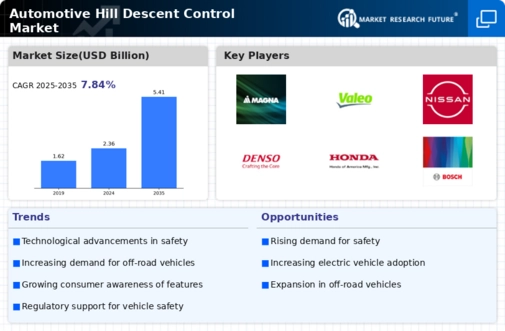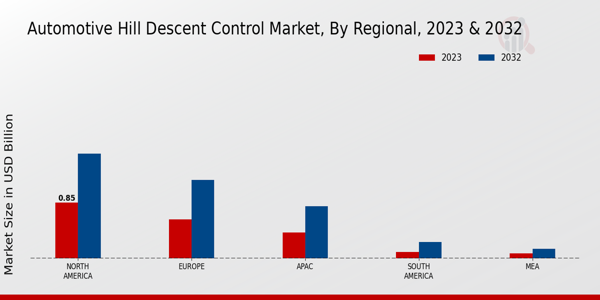Market Growth Projections
Growth of the Electric Vehicle Market
The growth of the electric vehicle market is poised to have a substantial impact on the Global Automotive Hill Descent Control Market Industry. As electric vehicles gain popularity, manufacturers are increasingly incorporating advanced technologies, including hill descent control systems, to enhance performance and safety. Electric vehicles often require specialized control systems to manage their unique weight distribution and braking characteristics, making hill descent control an essential feature. With the electric vehicle market projected to expand significantly in the coming years, the integration of hill descent control systems is likely to become a standard feature, further driving market growth.
Increasing Demand for Off-Road Vehicles
The Global Automotive Hill Descent Control Market Industry is experiencing a notable surge in demand for off-road vehicles, driven by a growing consumer preference for adventure and outdoor activities. This trend is particularly evident in regions with diverse terrains, where vehicles equipped with advanced hill descent control systems provide enhanced safety and performance. As of 2024, the market is projected to reach 2.36 USD Billion, reflecting the increasing integration of such technologies in new vehicle models. Manufacturers are responding to this demand by incorporating sophisticated hill descent control features, which not only improve vehicle stability but also enhance the overall driving experience in challenging conditions.
Government Regulations and Safety Standards
Government regulations and safety standards are critical drivers of the Global Automotive Hill Descent Control Market Industry. Many countries are implementing stricter safety regulations that mandate the inclusion of advanced safety features in new vehicles. Hill descent control systems are increasingly recognized as essential for enhancing vehicle safety, particularly in regions prone to steep inclines and challenging terrains. Compliance with these regulations not only ensures consumer safety but also enhances manufacturers' market competitiveness. As a result, the market is expected to grow significantly, with projections indicating a rise to 5.41 USD Billion by 2035, as more manufacturers integrate hill descent control systems to meet regulatory requirements.
Rising Awareness of Vehicle Safety Features
There is a growing awareness among consumers regarding the importance of vehicle safety features, which significantly influences the Global Automotive Hill Descent Control Market Industry. As consumers become more informed about the benefits of advanced safety technologies, they are increasingly seeking vehicles equipped with hill descent control systems. This heightened awareness is particularly pronounced in markets with challenging driving conditions, where such features can prevent accidents and enhance driver confidence. The market's projected CAGR of 7.84% from 2025 to 2035 indicates a robust growth trajectory, driven by consumer demand for safer vehicles that incorporate innovative technologies like hill descent control.
Technological Advancements in Vehicle Safety
Technological advancements play a pivotal role in shaping the Global Automotive Hill Descent Control Market Industry. Innovations in electronic stability control and sensor technologies have led to the development of more sophisticated hill descent control systems. These systems utilize real-time data to optimize braking and throttle control, ensuring a smooth descent on steep slopes. As safety regulations become more stringent, manufacturers are compelled to adopt these technologies to comply with global standards. The anticipated growth of the market, projected to reach 5.41 USD Billion by 2035, underscores the importance of integrating advanced safety features, including hill descent control, into modern vehicles.














